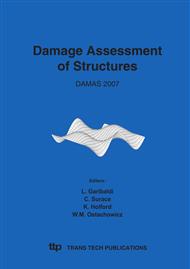p.421
p.427
p.435
p.441
p.447
p.455
p.461
p.467
p.473
Distributions of Local Damage Variable and Local Plastic Tensile Strain and Precursors to Failure of Quasi-Brittle Pure Bending Beam
Abstract:
For many quasi-brittle materials (such as rock, ceramic and concrete) in pure bending state, the material on the tensile side will fail firstly since the compressive strength can be ten times the tensile strength. After tensile strain localization zone is initiated in the midspan of the beam, its propagation direction will be perpendicular to the neutral axis. In the paper, using nonlocal theory or gradient-dependent plasticity, the distributions of local plastic tensile strain and local damage variable in tensile strain localization zone of a pure bending beam are analyzed theoretically. The evolutions of the maximum local plastic tensile strain, the maximum local damage variable and the bending moment with tensile stress acting on the tensile side are presented through examples. The distributions of local plastic tensile strain and local damage variable in tensile strain localization zone are highly nonuniform due to microstructural effect. When the maximum bending moment is reached, the maximum local damage variable is proportional to the ratio of elastic modulus to elastoplastic modulus, while the maximum local plastic tensile strain is inversely proportional to elastic modulus and elastoplastic modulus. For quasi-brittle materials, the elastoplastic modulus that is a constitutive parameter equal to the absolute value of the slope of tensile stress-tensile strain curve in strain-softening stage is much higher. The present theoretical results mean that the precursors to failure are less apparent for extremely brittle materials.
Info:
Periodical:
Pages:
447-452
Citation:
Online since:
September 2007
Authors:
Price:
Сopyright:
© 2007 Trans Tech Publications Ltd. All Rights Reserved
Share:
Citation:


